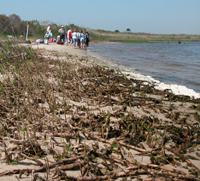 |
 | |
  | |
|
|
|
|
Fire Island National Seashore
Pests
|
|
|
|
|
| |
 |
|
Fire Island National Seashore is a complex park with a number of historic and modern structures, landscapes, and natural areas, including wilderness and dynamic coastal dunes with accompanying vegetation. Beyond the usual assortment of urban and rural pest issues, extensive populations of exotic invasive plants present an additional challenge. Invasive plants and animals often find their way into the park through neighboring non-federal lands.
|
 |
| A tangled mat of rhizomes and roots of the common reed, or Phragmites, are exposed along the bay shoreline in early summer. |
 |
An in 2002 found fifteen invasive plant species on Fire Island. Weeds were found predominantly in disturbed areas, such as along boardwalks, around buildings, and wherever there is vehicular or pedestrian traffic. The barrier island's nutrient-poor soils, desert-like conditions and salt spray prevent many weeds from gaining a strong foothold on Fire Island.
The most prominent invasive plant species on Fire Island is the common reed, or Phragmites australis. This plant, which can grow up to 20 feet high, forms dense stands by a network of roots and rhizomes. One plant can spread more than 10 feet in a single growing season.
Fire Island's most abundant weeds include the autumn olive (Eleagnus umbellata), nodding thistle (Carduus nutans) and spotted knapweed (Centaurea aculosa).
|
|
Learn More
The National Park Service implements a nationwide Integrated Pest Management Program to reduce risks to the public, park resources, and the environment from pests and pest-related management strategies.
An IPM Plan for Fire Island National Seashore was prepared in 2006. The report may be available as a downloadable portable document format (PDF) file from the Internet at http://www.nps.gov/nero/science/.
|
|
|
|

Fire Island Habitats
Learn more about the natural features and ecosystems of Fire Island National Seashore.
more... | | 
Barrier Island Vegetation
Fire Island supports a variety of plants in its diverse habitats.
more... | | 
Fire Island Mammals
Wildlife on Fire Island includes a few large mammals, although most are inconspicuous.
more... | |
|
|
|
|
|
|
|
 |
|
Did You Know?
The 4-day Fire Island Trek began as a special event in September, 2004, in celebration of Fire Island National Seashore's 40th anniversary. The program has been continued as a means to showcase the variety of resources and recreational and educational opportunities that exist on Fire Island.
more...
|
|
|
|
Last Updated: March 08, 2007 at 11:47 EST |






